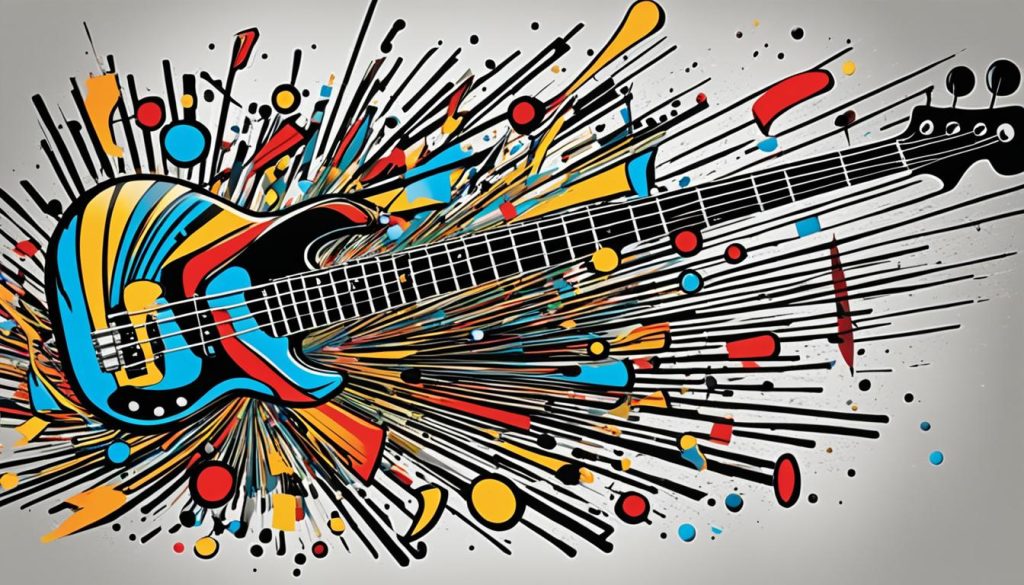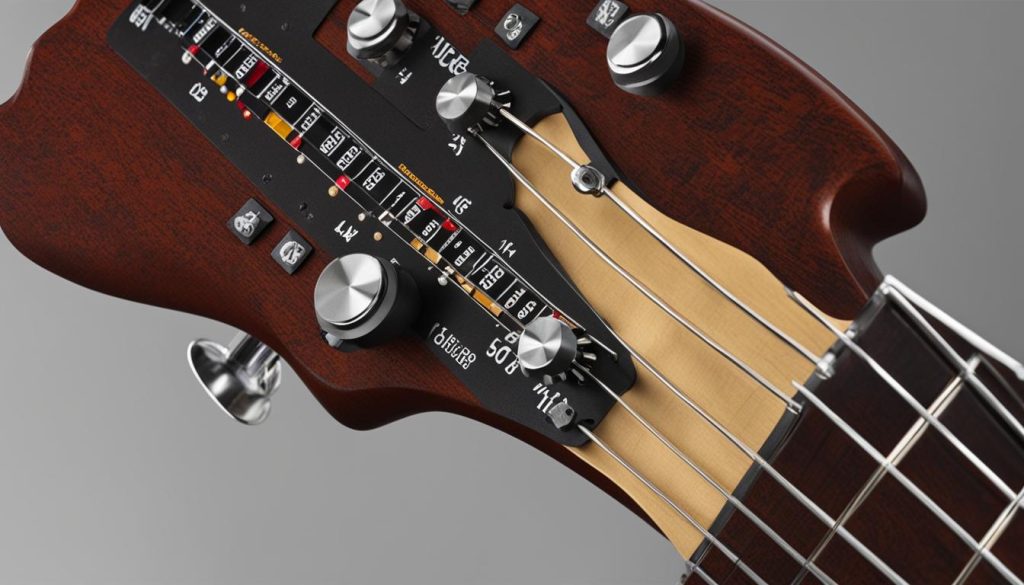In this article, I will share with you some advanced techniques that will elevate your groove and help you take your bass guitar skills to the next level. Whether you’re an experienced bassist looking to add more creativity to your playing or a beginner who wants to explore new possibilities, these expert tips and insights will guide you towards unlocking your full potential as a bass guitarist.
Key Takeaways:
- Mastering shuffle and swing rhythms is essential for creating a solid groove.
- Understanding bass sliding techniques and scale application will add expression to your bass lines.
- Increasing your bass playing speed requires a focused practice routine and attention to technique.
- Exploring arpeggios, modes, and chords will expand your harmonic vocabulary.
- Incorporating these advanced techniques into your practice routine will elevate your groove and skill level.
Going Beyond the Basics: Shuffle and Swing Rhythms
When it comes to advanced bass techniques, mastering shuffle and swing rhythms is essential for taking your groove to the next level. These rhythmic patterns add a unique feel and flavor to your bass playing, making it more dynamic and exciting.
Shuffle rhythms, characterized by their syncopated and swinging nature, are a staple in many genres like blues, rock, and jazz. They involve playing a dotted eighth-note followed by a sixteenth-note, creating a bouncy and infectious groove. Here’s an example:
Bassline Example:
G|——————–
D|———3–4——-
A|—3–5————
E|——————–
Swing rhythms, on the other hand, have a looser and more relaxed feel. They are commonly used in jazz and swing music and involve playing eighth-notes with a swing or shuffle feel. This means that the first eighth-note in a pair is slightly longer, while the second one is slightly shorter, creating a rhythmic push and pull. Here’s an example:
Bassline Example:
G|——————–
D|———5–3——-
A|—5–7————
E|——————–
To develop your skills in shuffle and swing rhythms, it’s important to practice with metronomes or drum loops that emphasize these rhythmic feels. Start by playing along to simple songs or backing tracks in shuffle or swing styles, and gradually increase the tempo as you become more comfortable.
Here are some exercises that will help you internalize shuffle and swing rhythms:
- Play quarter-note roots in a shuffle feel while emphasizing the off-beats.
- Practice playing walking basslines with swing rhythms, focusing on the articulation and groove.
- Experiment with different note durations and accents to create interesting rhythmic variations.
- Transcribe and learn basslines from shuffle and swing tunes to get a feel for how other bassists incorporate these rhythms into their playing.
Remember, mastering shuffle and swing rhythms will greatly enhance your bass playing and allow you to create grooves that make people want to move.

| Shuffle Rhythms | Swing Rhythms |
|---|---|
| Syncopated | Loose and relaxed |
| Dotted eighth-note followed by a sixteenth-note | Eighth-notes with a swing or shuffle feel |
| Commonly used in genres like blues, rock, and jazz | Commonly used in jazz and swing music |
Bass Sliding Techniques and Scale Application
In the world of advanced bass techniques, bass sliding is a skill that can truly elevate your playing. Mastering the art of sliding allows you to add a unique touch to your bass lines, creating a smooth and expressive sound that captures the attention of listeners.
To effectively use sliding in your playing, it’s important to understand how it works and how it can be applied with scales to create melodic lines. By incorporating sliding techniques into your bass playing, you can seamlessly connect different areas of the fretboard, opening up new possibilities for creativity and musical expression.
One way to incorporate sliding into your playing is by using it to connect different notes within a scale. By sliding from one note to another, you can create a smooth and fluid transition, adding depth and character to your bass lines. Experiment with sliding between different scale degrees to create melodic phrases that stand out.

Here’s an example using the A major scale in the 5th position:
| Note | Fret |
|---|---|
| A | 5 |
| B | 7 |
| C# | 9 |
| D | 7 |
| E | 9 |
| F# | 9 |
| G# | 7 |
| A | 5 |
In this example, you can experiment with sliding from one note to another, such as sliding from the 5th fret to the 7th fret to transition from A to B. This creates a smooth and seamless connection between the two notes, adding a touch of elegance to your bass lines.
By incorporating sliding techniques with scales, you can create melodic lines that flow effortlessly across the fretboard. This technique allows you to explore different tonalities within the same scale, adding richness and complexity to your bass playing.
“Sliding is like painting with sound. It adds an element of expression and emotion to your bass lines that can’t be achieved with static notes alone.” – Bassist Ryan Smith
In conclusion, bass sliding is an essential advanced technique that every bass player should master. By incorporating sliding techniques into your playing and applying them with scales, you can add depth, expression, and creative flair to your bass lines. So grab your bass guitar, explore the possibilities of sliding, and discover new ways to elevate your playing.
Increasing Bass Playing Speed
As a bass player, it’s natural to strive for greater speed and agility in your playing. Whether you want to wow the crowd with lightning-fast basslines or simply improve your overall technique, increasing your playing speed is a valuable skill to have. In this section, I’ll share some tips and exercises that will help you ramp up your bass playing speed while maintaining precision and accuracy.
Developing a Practice Routine
Consistency is key when it comes to improving your speed on bass. Establishing a regular practice routine will enable you to focus on specific techniques and build muscle memory over time. Consider dedicating a portion of your practice sessions exclusively to speed development. By setting aside dedicated practice time, you can effectively track your progress and see tangible improvements.
When designing your practice routine, make sure to incorporate exercises that target your finger dexterity and hand coordination. Start with slower tempos and gradually increase the speed as you become more comfortable. Remember to always practice at a tempo that allows for clean and accurate execution of the techniques.
“By setting aside dedicated practice time, you can effectively track your progress and see tangible improvements.”
Focusing on Technique
While speed is important, it should never come at the expense of proper technique. To play fast and clean, it’s crucial to maintain a relaxed and efficient playing style. Pay attention to your posture, hand position, and finger placement to avoid unnecessary tension and strain. Incorporate exercises that specifically target your technique, such as alternate picking, string skipping, and fretting efficiency drills.
Additionally, utilizing proper finger and thumb placement can greatly improve your speed. Experiment with different finger positions and hand placements to find what works best for you. You may also consider experimenting with different types of bass strings to find a gauge and tension that suits your playing style and facilitates faster playing.
Exercises to Increase Speed
Now that we’ve covered the importance of practice routine and technique, let’s dive into some specific exercises that will help you increase your bass playing speed:
- Metronome Practice: Use a metronome to practice playing scales and exercises at gradually increasing tempos. Start at a comfortable speed and gradually work your way up, maintaining clean and accurate playing throughout.
- Speed Bursts: Choose a short musical passage or riff and play it as fast as you can for a brief burst, focusing on clean execution. Gradually increase the duration of each burst as your speed improves.
- Scale Sequences: Practice playing scales in different sequences, such as thirds, fourths, and fifths. This will not only improve your finger dexterity but also train your ears to recognize patterns and intervals.
Remember to start slow and gradually increase the tempo as you become more comfortable. Speed development takes time and patience, so don’t get discouraged if progress feels slow at first. The key is to consistently practice with focus and determination.
Visualization Exercises
Aside from physical practice, visualization exercises can also be a valuable tool in increasing your speed. Take a few moments each day to visualize yourself effortlessly playing fast basslines with precision and fluidity. This mental rehearsal can help reinforce the neural pathways associated with fast playing and build confidence in your abilities.
Summary
Increasing your bass playing speed requires a combination of dedicated practice, focus on technique, and patience. By developing a regular practice routine, honing your technique, and incorporating specific exercises, you can steadily improve your speed and agility on the bass. Remember to start slow, maintain precision and accuracy, and celebrate every milestone along the way. With consistent effort and the right mindset, you’ll soon be blazing through basslines like a pro.

| Exercise | Description |
|---|---|
| Metronome Practice | Use a metronome to practice scales and exercises at increasing tempos |
| Speed Bursts | Play short musical passages or riffs as fast as you can in brief bursts |
| Scale Sequences | Practice scales in different sequences to improve finger dexterity and ear training |
Exploring Different Bass Techniques: Arpeggios, Modes, and Chords
Now that we’ve covered some essential advanced bass techniques, let’s dive into the exciting world of arpeggios, modes, and chords. These elements are fundamental to expanding your harmonic content and adding depth to your bass lines. By understanding how to use arpeggios, modes, and chords effectively, you’ll be able to create more interesting and captivating bass melodies.
Arpeggios:
An arpeggio is a broken chord where the individual notes of the chord are played in succession. It adds a melodic touch to your bass playing and can be used to create smooth, flowing lines. By incorporating arpeggios into your bass lines, you can outline the harmonic structure of a song or add flavor to your improvisation. Here’s an example of a basic arpeggio pattern for a major chord:
| String | Fret |
|---|---|
| E | 5 |
| A | 7 |
| D | 7 |
| G | 6 |
Modes:
Modes are scales derived from the major scale and have unique tonal characteristics. They provide a rich palette of sounds for you to explore on the bass guitar. By incorporating different modes into your playing, you can add color and variation to your bass lines. Each mode has its own distinct pattern and feeling. Here are some common modes and their associated intervals:
- Ionian (Major): W-W-H-W-W-W-H
- Dorian: W-H-W-W-W-H-W
- Phrygian: H-W-W-W-H-W-W
- Lydian: W-W-W-H-W-W-H
- Mixolydian: W-W-H-W-W-H-W
- Aeolian (Natural Minor): W-H-W-W-H-W-W
- Locrian: H-W-W-H-W-W-W
Chords:
Understanding chords will greatly enhance your bass playing. Knowing how to construct and play different chord voicings will allow you to support other musicians, create harmony, and add interesting textures to your bass lines. Experiment with different chord voicings and explore their harmonic content. Here’s an example of a common major chord voicing:
| String | Fret |
|---|---|
| E | 7 |
| A | 9 |
| D | 9 |
| G | 9 |
By incorporating arpeggios, modes, and chords into your playing, you can expand your harmonic vocabulary and create more captivating bass lines. Practice these techniques and experiment with different patterns, variations, and rhythmic ideas to develop your own unique style. With time and dedication, these techniques will become second nature, allowing you to express yourself fully on the bass guitar.

Conclusion
In conclusion, incorporating these advanced bass techniques into your practice routine will elevate your groove, expand your skill set, and allow you to create your own signature sounds on the bass guitar. By mastering shuffle and swing rhythms, bass sliding techniques, increasing your playing speed, and exploring arpeggios, modes, and chords, you’ll unlock new levels of creativity and musicality.
Remember to practice regularly and have fun exploring these new techniques. Dedicate time each day to focused practice, gradually building upon your foundation. Consistency and perseverance are key to mastering these advanced bass techniques. As you progress, experiment with combining different techniques to develop your unique style.
With dedication and an open mind, the sky’s the limit for your bass playing potential. Embrace the challenge of mastering these advanced techniques, and don’t be afraid to push yourself outside of your comfort zone. Embody the passion and groove that drives you as a bass player, and let your bass guitar become an extension of your musical personality.
FAQ
What are some advanced techniques for bass guitar?
Some advanced techniques for bass guitar include mastering shuffle and swing rhythms, bass sliding techniques, increasing playing speed, and exploring techniques such as arpeggios, modes, and chords.
How do I master shuffle and swing rhythms on bass guitar?
To master shuffle and swing rhythms on bass guitar, it is important to understand the rhythmic patterns and practice executing them accurately. Easy examples and exercises can help you develop your skills in this area.
How can I effectively use bass sliding in my playing?
Bass sliding can be effectively used in your playing by learning how to apply it with scales to create melodic lines. This technique helps you connect different areas of the fretboard and add expression to your bass lines.
How can I increase my bass playing speed?
To increase your bass playing speed, it is important to develop a practice routine that focuses on technique. Tips and exercises can help you achieve faster playing without sacrificing precision and accuracy.
How can I explore different bass techniques such as arpeggios, modes, and chords?
You can explore different bass techniques such as arpeggios, modes, and chords by understanding how to use these elements in your playing. Examples and exercises can help you master these techniques and expand your harmonic vocabulary.
Source Links
- http://bassguitarplayerworld.com/advanced/
- https://hub.yamaha.com/guitars/bass/six-essential-bass-playing-techniques/
- https://www.basslinepublishing.com/product/advanced-studies-for-bass-guitar/

Bass Punch
Bass Punch is curated by a group of passionate guitarists and bassists, offering a wealth of informational content. This collective of experts shares their insights, techniques, and knowledge with readers, aiming to educate and inspire enthusiasts across all levels of proficiency. The blog serves as a hub for those seeking to deepen their understanding of bass and guitar, providing valuable resources and guidance from seasoned professionals in the field.
